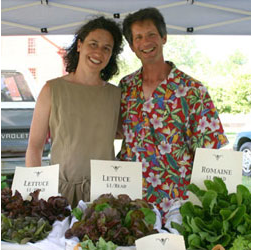
Have you ever dreamed of quitting your city job, moving to a rural area, growing a big garden, heating with wood, raising chickens, and making a living in the country?
Steven and Karen Trubitt dreamed it…then they did it. And they’re making it all work today market farming (or “micro-farming”) on their flourishing rural homestead a few miles outside North Bennington, Vermont — True Love Farm.
Stepping out of the City and into the Country
Steven was a professional photographer. Karen was a professional fundraiser. They lived in Minneapolis and they wanted out. “We wanted to get out of the city and live where we had a relationship with the land,” says Karen.
The Trubitts’ Hard-Won Wisdom
Steven and Karen shared wisdom born of experience over coffee at True Love Farm’s headquarters — their big kitchen table.
- “Yes, you can make a living as a market gardener. But many small farms are not financially self-supporting. Many have one partner working off the farm to supplement the farm’s income and provide health insurance.”
- “Work on your soil first. Work on improving its tilth and organic content. Use cover crops and crop rotation.”
- “Growing vegetables is easy — the plants want to grow. Selling them is easy. But selling them at a profit is the tricky part.”
- “Gardeners can lavish attention on individual plants. In farming, there’s not time for that. Our big advantage is the plants want to live. We give them what they need and, at a certain point, they’re on their own.”
- “Plan on growing gradually into market gardening as a business. Don’t over-extend yourself financially. Think it through, do your homework, and don’t quit your day job.”
A job offer in Vermont gave them a point of entry into a more rural lifestyle and their local search brought them to a 30-acre piece of an old family farm, complete with an 1790’s barn on the structural tipping point – rehab it or tear it down and start over? (They rehabbed.)
“We Didn’t Set out to be Micro-Farmers.”
“We didn’t set out to be micro-farmers,” Karen told us. “It grew organically out of owning the land.” Karen had a little gardening history, if only vicariously, growing up in a family that gardened. Steven’s gardening resume consisted in its entirety of growing six tomato plants.
Challenges followed. Hail pounded their crops — the ones the deer didn’t get to first. Snails slimed. Flea beetles bit. Weeds invaded. But year by year, the Trubitts expanded their cultivated areas; improved the soil; added irrigation systems, greenhouses, tools, and equipment; and increased their knowledge of market gardening.
Their success grew, too. “We’ve been very fortunate,” says Steven. “There’s a growing trend toward sustainable, local agriculture. It’s not just a fad. Farmers markets have been popping up at a tremendous rate over the past 15 years.”
Current Trends Favor Market Gardeners
The growth in market gardening has been aided, too, by the increasing number of “locavores” – those who prefer to eat what’s grown locally. This movement supports a “buy local” philosophy as a form of eco-consciousness: locally grown foods haven’t been transported hundreds or thousands of miles and haven’t grown a big, fat carbon footprint.
While the overall number of family farms is declining nationwide, “micro-farming” is growing. “There’s a nationwide increase in the number of small farms,” says Steven. “Growth in farm numbers is in mirco-farms including people who have big gardens and sell some of what they grow.”
Five Acres and Independence
In this, True Love Farm’s seventh year, Karen has joined Steven as a full-time market gardener. Today, the Trubitts are micro-farming five acres of crops including heirloom tomatoes, beans, mixed greens, potatoes, winter squash, garlic, cut flowers, herbs, blueberries and much more. Their pre-season seed order includes more than 100 different vegetable varieties.
The biggest challenge Karen and Steven face today? Keeping up with demand for their premium quality, locally grown, “hand-crafted” micro-farm produce.